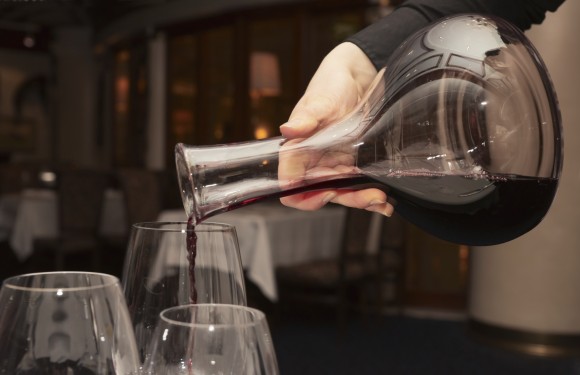How and When to Decant Red Wine

Decant red wine either to aerate a young wine, or to get rid of unwanted sediment in a mature wine. The latter is the more elaborate procedure.
It was at a professional wine tasting many years ago that I became aware of the art of wine decanting. A bottle of fine St. Julien wine from Bordeaux, a Château Beychevelle 1928, was carefully poured. First, the wine expert told us, we had to stop pouring when the remaining wine in the bottle reached the sediment level. Second, once poured the wine should be consumed fairly quickly. It was a gift from the past, and would not last.
We watched the process with fascination, looking forward to our turn to taste the wine. We saw the sediment, helped by a small flashlight held by our expert. “A candle held behind the bottle would do just as well, and provide better atmospherics,” she said. “But you must stop pouring before the sediment begins to flow.”
And we saw what she meant, as a thin layer of sediment began to appear, towards the bottom of the bottle. And then we tasted what she meant. The wine, then perhaps forty years old, tasted delicious, on the light, delicate side.
Our expert had told us to save a sip of the wine. Half an hour later we returned to that sip in our glasses and tasted it. There was nothing but a taste of ash and wine residue. “That’s the final lesson,” she said. “An old wine once decanted must be drunk in a fairly short period of time.”
Since that time I have enjoyed old wines, helped by careful decanting. A bottle of Château Ausone was savored at a luncheon at the château; it was served by the winemaker himself, a rare honor.
It was a “45,” I was told, and I found it enjoyable, with traces of recent Ausone wines. Then out hostess smiled: “Actually it is an 1845,” she said. Just think, this vintage could have been enjoyed by a survivor of the French Revolution! And in ten minutes at the most, the wine had crumbled into water and ash.
For our wedding anniversary, I had saved a bottle of Château Brane Cantenac 1960, from the Margaux region. We were celebrating on a cruise, and I asked the sommelier not to open the wine before the dinner. He opened it just as the main course was being served, decanting carefully. Then we enjoyed this fine wine, on its 50th anniversary!
That is the reason for decanting old red wines. One must give them some chance to breathe, and rid them of sediment at the same time, always bearing in mind that an old wine is a perishable commodity. But the process may be harder than it sounds.
What if the cork breaks? In my experience, that often happens. The cork of a properly stored bottle of wine will absorb so much wine, and that creates a fault line, where a corkscrew will simply break the cork. That is the last thing that you want to happen at your dinner party.
I have found two strategies helpful in preventing this.
- First, before serving the wine, simply store it in your wine cooler upside down for a day! Then, half a day before dinner, put it in the proper position. The sediment will be back in the bottom of the bottle, and the cork should be moistened all the way through, minimizing the danger of the cork breaking.
- Second, instead of the usual corkscrew, remove the cork with a Vintage Cork Puller. This is an inexpensive, two pronged device, and the blades are inserted between the cork and the bottle. Twist them around, and the cork should lift without breaking. If not, you should be able to push the unbroken cork into the bottle. At this point, wipe clean the bottleneck then pour the wine carefully into a decanter, stopping as the sediment appears. (To make sure of this, I sometimes use a tea strainer.)
With a younger wine, sediment will not be a problem. Here, though, the wine might not be sufficiently aged, which means that it has not fully developed. What you want to do is to aerate the wine.
The act of pouring the wine into a decanter helps this process. Then leave it in the decanter for an hour (if a young wine) or perhaps twenty minutes (if a mature wine). What you have done is artificially speed up the wine’s natural aging process. But don’t do this with sparkling wines, and I would be careful about doing it with white wines. In time, you will find the decanting time that fits your palate.
And may all of your wine corks emerge unbroken from the bottle!
Do you decant your red wine? Comment below!
Sign up for our eNewsletter and receive our FREE wine tasting guide.

